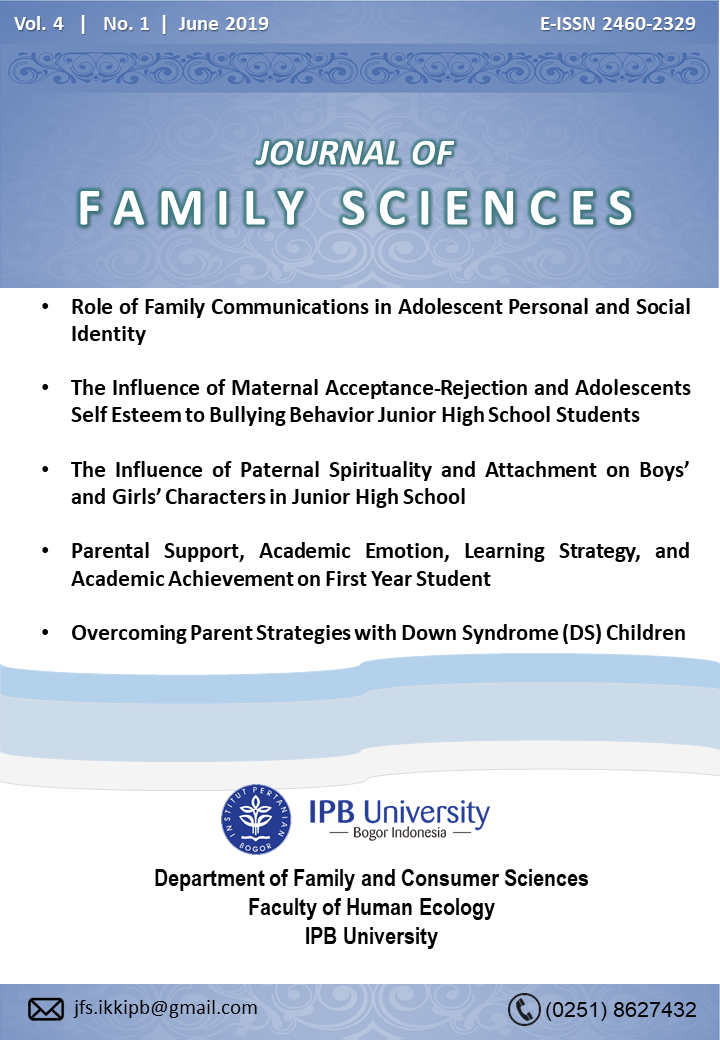The Influence of Paternal Spirituality and Attachment on Boys’ and Girls’ Characters in Junior High School
Abstract
Proper parenting reflected on the goodness of parental spirituality and attachment in which affected adolescents' character development. The research was aim to examine the influence of paternal spirituality and attachment towards adolescents' character. This study used a cross-sectional study design which involved 84 respondents from one of the public high school in Bogor City and consisted of 37 boys and 47 girls, samples were chosen by cluster random sampling technique. Data were analyzed descriptively, independent t-test, Pearson correlation, and multiple linear regression. Data was gathered by self-report questionnaires. The research found that paternal spirituality and attachment had a better score than the boys. Also, politeness and perseverance characters of girls better than the boys. Moreover, the better paternal spirituality and attachment the better character of adolescents. The result of the multiple linear regression test shows that paternal spirituality and attachment became the main factors in affecting adolescents' character in junior high school.
Downloads
References
Arca CC. (2007). The role of spirituality and its influence on filipino parents‟ childrearing practices [thesis]. Department of social work california state university, long beach in partial fulfillment of the requirements for the degree master of social work.
Armsden GC, Greenberg, MT. (1987). The inventory of parent and peer attachment: relationship to well-being in adolescence. Journal of Youth and Adolescence. 16 (5): 427-454. DOI: 10.1007/BF02202939
Bowlby J. (1969). Attachment and Loss. New York (USA): Basic Books.
Choon LJ, Hasbullah M, Ahmad S, Wu SL. (2013). Parental attacment, peer attachment, and delinquency among adolescents in Selangor, Malaysia. Journal of Asian Social Science. 9(15):214-219). http://dx.doi.org/ass.v9n15p214
Desrosiers A, Kelley BS, Miller L. (2011). Parent and peer relationships and relational spirituality in adolescents and young adults. Journal of Psychology of Religion and Spirituality 3(1): 39-54.
Dewanggi M, Hastuti D, Herawati T. (2015). The influence of attachment and quality of parenting and parenting environment on children’s character in rural and urban areas of Bogor. Jurnal Ilmu Keluarga dan Konsumen 8(1):20-27.
Diblasio FA, Bandura BB. (1990). Adolescent sexual behavior: Multivariate analysis of a social learning model. Journal of Adolescent Research, 5, 449–466.
[Ditjenpas] Direktorat Jenderal Pemasyarakatan. (2018). Data Terakhir Jumlah Penghuni per-UPT pada Kanwil [internet]. Diambil dari: http://smslap.ditjenpas.go.id [diakses pada November 2018].
Dollahite DC. (1998). Fathering, faith, and spirituality. Journal of Mens Studies. doi:10.3149/jms.0701.3
Fitriani W, Hastuti D. (2016). Pengaruh kelekatan remaja dengan ibu, ayah, dan teman sebaya terhadap kenakalan remaja di lembaga pembinaan khusus anak (LPKA) kelas II bandung. Jurnal ilmu keluarga dan konsumen. 9(3): 206-217.
Freeman H, Shepherd DDC, Newland LA. (2010). New directions in father attachment. Journal of Early Child Development and Care 180:1-8. doi: 10.1080/03004430903414646
Gunarsa S, Gunarsa Y. (2004). Psikologi Praktis: Anak, Remaja dan Keluarga. Jakarta (ID): BPK Gunung Mulia.
Hastuti D, Alfiasari, Ajeng N, Novita L. (2017). Karakter Dwi Asas: Sopan Santun dan Tekun. IPB Press: Bogor.
Hastuti D. (2015). Pengasuhan :Teori, Prinsip, dan Aplikasinya di Indonesia. Bogor (ID) : IPB Press.
Hastings PD, Utendale WT, Sullivan C. (2007). The socialization of prosocial development. Handbook of Socialization: Theory and Research. California (US): Guillford Publications.
Hoeve M, Stams GJJM, Put CE, Dubas JS, Laan PH, dan Gerris JRM. (2012). A meta-analysis of attachment to parents and delinquency. Journal of Abnormal Child Psychology .(40): 771-785. DOI 10.1007/s10802-011-9608-1
Karina, Hastuti D, Alfiasari. (2013). Perilaku bullying dan karakter remaja serta kaitannya dengan karakteristik keluarga dan peer group. Jurnal Ilmu Keluarga dan Konsumen 8(1):20-29.
Kohlberg L. dan Hersh R.H. (1977). Moral development: a review of the theory. Theory into Practice 16 (2): 53-59.
Laible D. (2007). Attachment with parents and peers in late adolescence:Links with emotional competence and social behavior. Journal of Personality and Individual Differences . 43(2007):1185-1197. doi:10.1016/j.paid.2007.03.010
Laursen B, Collins WA. (2004). Parent-child communication during adolescence. Handbook of Family Communication. Mahwah, NJ, US: Lawrence Erlbaum Associates Publishers.
Lestari TG. (2017). Pengaruh lingkungan pengasuhan dan kelekatan ayah terhadap karakter sopan santun remaja di perdesaan [skripsi]. Departemen Ilmu Keluarga dan Konsumen, Fakultas Ekologi Manusia, IPB.
Lickona T. (2004). Why Character Matters. New York(USA): Tounchstone
Development. USA: Bantam Books.
_____. (2001). What is good character? Journal Reclaiming Children and Youth. 9(4): 239.
_____. (1991). Education for Character: Mendidik untuk Membentuk Karakter Bagaimana Sekolah Dapat Mengajarkan Sikap Sopan Santun dan Tanggung Jawab. Wamaungo JA, penerjemah; Wahyudin U, editor. Jakarta (ID): Penerbit PT Bumi Aksara. Terjemahan dari: Educating for Character: How Our School Can Teach Respect and Responsibility.
Mancini L. (2010). Father absence and its effects on daughters (Tesis). Western Connecticut State University, Connecticut, United States.
Megawangi R. (2009). Pendidikan Karakter: Solusi yang Tepat untuk Membangun Bangsa. Bogor (ID): Indonesia Heritage Foundation.
_____. (2016). Pendidikan Karakter untuk membangun masyarakat madani. Jakarta (ID): IPPK Indonesia Heritage Foundation
_____. (2016). Pendidikan Karakter untuk membangun masyarakat madani. Jakarta (ID): IPPK Indonesia Heritage Foundation.
Moitra T, Mukherjee I. (2012). Parent-adolescent communication and delinquency: A comparative study in Kolkata, India. Europe’s Journal of Psychology 8 (1): 74-94. doi:10.5964/ejop.v8i1.299
Moretti MM, Peled M. (2004). Adolescent-parent attachment:Bonds that support healthy development. Journal of Pediatr Child Health 9(8):551-555.
Ngun TC, Ghahramani N, Sanchez FJ, Bocklandt S, Vilain E. (2010). The genetics of sex differences in brain and behavior. Journal of Frontiers in Neuroendocrinology 32(2): 227-246.
Papalia DE, Olds SW. (1986). Human development. New York(USA): McGraw Hill Book Company.
Pasaribu RM, Hastuti D, Alfiasari. (2013). Gaya pengasuhan permisif dan rendahnya sosialisasi nilai dalam keluarga berisiko terhadap penurunan karakter remaja. Jurnal Ilmu Keluarga dan Konsumen .6(3):163-171.
Puspitasari R, Hastuti D, Herawati T. (2016). Pengaruh pola asuh disiplin dan spiritual serta kecerdasan spiritual ibu terhadap karakter anak usia sekolah dasar di perdesaan. Jurnal Ilmu Keluarga dan Konsumen .9(2):101-112.
Sancassiani F, Moro M, Cossu G, Angermeyer M, Carta MG, et al. (2015). Enhancing the emotional and social sklls of the youth to promote wellbeing and positive development: A systematic review of universal school-based randomized controlled trials. Journal of Clinical Practice & Epidemiology in Mental Health 2015 (11):21-40. doi: 10.2174/1745017901511010021.
Santrock JW, Hardani W. (2007). Perkembangan Anak, Edisi Ketujuh, Jilid Dua. Mila Rachmawati dan Anna Kuswanti, penerjemah. Jakarta (ID): Erlangga.
Setyowati YD, Krisnatuti D, Hastuti D. (2017). Pengaruh kesiapan menjadi orangtua dan pola asuh psikososial terhadap perkembangan sosial anak. Jurnal Ilmu Keluarga dan Konsumen .10(2):95-106. doi:http://dx.doi.org/10.24156/jikk.2017.10.2.95
Shah AA. (2004). Self religiosity, father’s attitude and religious education in the moral behavior of adolescents. Journal of Psychology and Developing Societie 16 (2):187-207. doi:10.1177/097133360401600206.
Shumaker DM, Deutsch RM, Brenninkmeyer L.(2010) How do I connect? attachment issues in adolescence. Journal of Child Custody 6(1-2):91-112. doi: 10.1080/15379410902894866
Situmorang ZRD, Hastuti D, Herawati T. (2016). Pengaruh kelekatan dan komunikasi dengan orang tua terhadap karakter remaja perdesaan. Jurnal Ilmu Keluarga dan Konsumen. 9(2): 113-123.
Snarey. (1993). How fathers care for the next generation: A four decade study. Boston: Harvard University Press.
Song H, Thompson RA, Ferrer E. (2009). Attachment and self-evaluation in Chinese adolescents: Age and gender differences. Journal of Adolescence . 32(5):1267-1286. doi:10.1016/j.adolescence.2009.01.001
Srikandi PD. (2013). Hubungan stimulasi psikososial dan metode sosialisasi dengan karakter disiplin dan hormat santun remaja pada keluarga bercerai [skripsi]. Bogor (ID): Program Sarjana Institut Pertanian Bogor.
Steinberg L. (2009). Adolescent development and juvenile justice. Annu. Rev. Clin. Psychol 2009 (5):47–73. doi: 10.1146/annurev.clinpsy.032408.153603.
Thomas AM. (2011). Parent and peer influences their role in predicting adolescent moral values and delinquent behavior [thesis]. Colorado: Human Development and Family Studies, Colorado State University, USA.
[UNICEF] United Nations Children Emergency Fund.(2015). Laporan Tahunan Indonesia 2015. Retrieved from: https://www.unicef.org/indonesia/id/Laporan_Tahunan_UNICEF_Indonesia_2015.
_____.(2016). Laporan Tahunan Indonesia 2016 . Retrieved from: https://www.unicef.org/indonesia/id/annualreport_Indonesia.2016_FINAL-preview
Van Ijzendoorn MH, Zwart-Woudstra HA. (1995). Adolescents' attachment representations and moral reasoning. Journal Genetic Psychology: Research and Theory on Human Development .156(3): 356-372. http://dx.doi.org/10.1080/00221325.1995.9914829
Varon SR, Riley AW. (1999). Relationship between maternal church attendance and adolescent mental health and social functioning. Psychiatric service 50(6):800-805.
Vries SL, Hoeve M, Stams G, Asscher JJ. (2015). Adolescent-parent attachment and externalizing behaviour: The mediating role of individual and social factors. Journal Abnorm Child Psychology .2016(44):283-294. DOI 10.1007/s10802-015-9999-5
Ying L, et al. (2015). Parental monitoring, parent-adolescent communication, and adolescents’ trust in their parents in China. Journal PloS ONE 10(8): e0134730. doi:10.1371/journal.pone.0134730
Yunus HH. (2017). Pengaruh pengasuhan ayah dan hubungan guru-siswa terhadap karakter tekun remaja perdesaan [skripsi]. Departemen Ilmu Keluarga dan Konsumen, Fakultas Ekologi Manusia, IPB
Authors who publish with this journal agree to the following terms:
- Authors retain copyright and grant the journal right of first publication with the work simultaneously licensed under

This work is licensed under a Creative Commons Attribution 4.0 International License. that allows others to share the work with an acknowledgement of the work's authorship and initial publication in this journal. - Authors are able to enter into separate, additional contractual arrangements for the non-exclusive distribution of the journal's published version of the work (e.g., post it to an institutional repository or publish it in a book), with an acknowledgement of its initial publication in this journal.
- Authors are permitted and encouraged to post their work online (e.g., in institutional repositories or on their website) prior to and during the submission process, as it can lead to productive exchanges, as well as earlier and greater citation of published work (See The Effect of Open Access).



_001.png)



